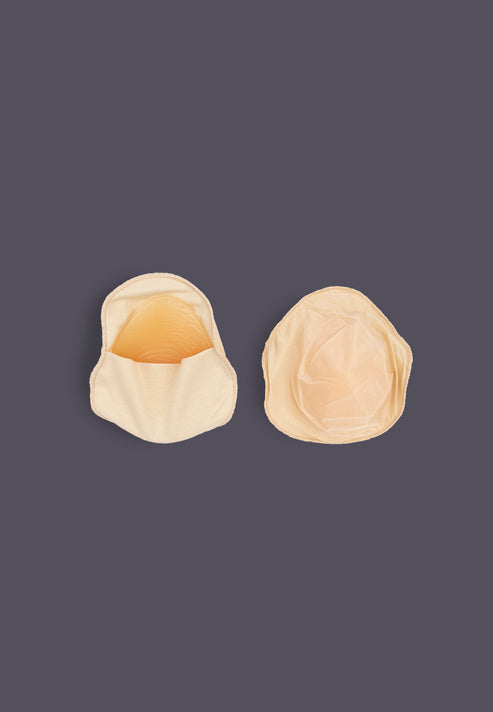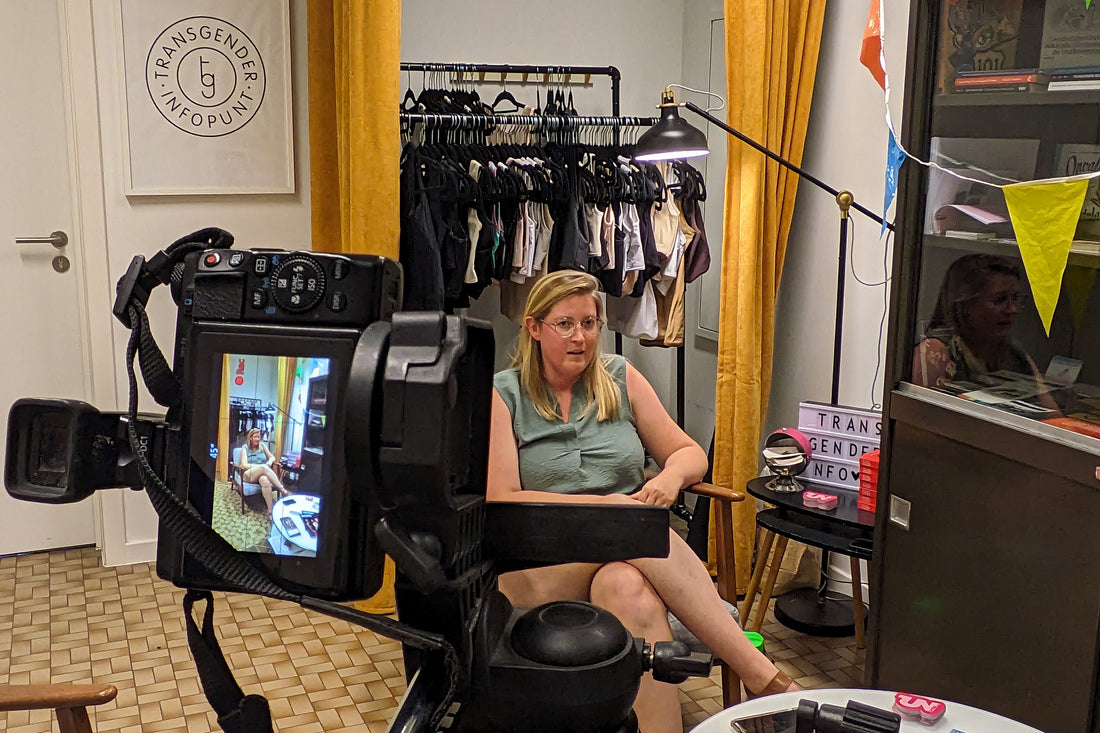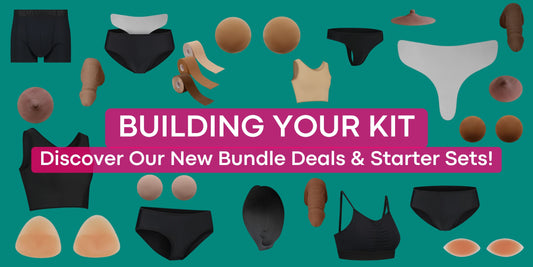At UNTAG we want to make sure that the information we provide to our customers is always up-to-date. With this in mind we have decided to visit experts in the trans-community. For our first visit we went to Transgender Infopunt (TIP) in Gent, Belgium. This is a Belgian organisation that you can go to with any questions regarding the transgender theme. We have asked them a range of questions about tucking and binding, and all of these answers can be found in this blog post.
Click here to visit the Transgender Infopunt's website.
On a Sunny Tuesday in September, me (Julia) and my colleague Anneloes drove from Amsterdam to the beautiful city of Gent, located in the heart of Belgium. Equipped with a camera, a microphone and a list of questions, we were ready to start our journey to Transgender Infopunt.
Before our visits we had asked our community on TikTok and Instagram to send in their questions about transitioning, wearing binders, or any other questions related to the trans-theme. We received questions about how to safely wear binders, what the consequences of tucking are, and how to deal with gender dysphoria. We’ve compiled all these questions into a list that we took with us on our visit to TIP.
After arriving at UZ Gent (the hospital that Transgender Infopunt resides in) we found our way through the maze of hallways and corridors, where we were kindly greeted by Eline (she/her). Eline is the resident employee of TIP. We were invited into TIP’s small but homely office space, which was filled with flyers, stickers, flags, posters - all things related to the trans theme with their bold colours and letters.
Before we started our interview, Eline explained what it actually is that TIP does: it’s an information centre for every person who has questions about gender, being trans and all other related topics. TIP is there for trans people, but also offers information and support to loved ones. A visit to their safe space is completely anonymous. Their office is located in UZ Gent, which houses the biggest gender team in Flanders. Their goal is to offer as much information and support as they can. You can walk in during office hours, or you can make an appointment during which you can ask questions or try a range of gender affirming products. They listen to questions, can refer you to the right care, or you can make a report with them if you’ve been the victim of transphobia. Make sure you visit TIP’s website to find more information about who they are and what they do.
After we’d asked Eline about the goals of TIP and what they do, it was time to start our Q&A session. We started by asking a few general questions, after which we dove into tips about tucking - and lastly we asked questions about binding. Keep reading to find out if we answered your question!
What is your general advice about dealing with gender dysphoria?
There are different ways to deal with this, but here are three tips. The first tip is to talk about it with people who are close to you. Having people that can listen to you and offer support can help feel less isolated and alone. This can be very difficult (we see this especially with teenagers), since it can feel very intimidating to talk about. But if you keep this dysphoria within yourself, it can only grow bigger and stronger. So talk to people! Secondly, it’s important to find recognition and representation. For example, watch movies about the topic or talk to people who are going through the same thing. This can help you recognize your battle and motivate you to take steps to deal with your dysphoria. Thirdly, gender affirming accessories and garments can be of great help since they match how you feel with how you look.
Also, check out the subwebsite www.gendervonk.be, for more information on how to deal with difficult feelings and thoughts, and tips on how to strengthen your resilience.
What is your general advice when it comes to wearing tucking underwear?
The general advice is to try and limit the time you wear tucking underwear to 8 hours per day. Don’t wear it when you’re sleeping, since your body needs to be able to breathe. If you feel pain or discomfort, it might be a good idea to plan a resting day where you don’t tuck, or to cut down the amount of days where you tuck. Pain or discomfort is a way of your body to signal that you might be wearing the item too long or too intensively. So an important piece of advice is to listen to your body.
Another tip is to make sure that the tucking underwear you’re buying is of good quality. Back in the day (and even to this day), some people would use duct tape to tuck - which is a bad idea since it can tear the skin around your genitals during removal. It’s not healthy for your body, it causes skin irritation, and it’s all around not advisable to use.
So you advise against wearing tape for tucking?
Well, there’s a difference between tapes that are specifically made to be worn on the skin, and other kinds of tape. But even with medical tape there hasn’t been conclusive medical research that determines if it’s completely safe or unsafe. More research needs to be done to definitively conclude whether medical tape is safe. We can of course tell the short term effects of using tape, but when it comes to fertility, or what taping does to the size of your penis or the effect on blood flow? To know these things more research needs to be done.
That is in fact our next question: which tucking technique is the safest for the male reproductive system?
As I’ve said, more research needs to be done to give definitive answers to these questions, but there are a couple of things you could keep in mind. Firstly, don’t use tape that wasn’t designed to be used on the body. Another important thing is to avoid wearing two pairs of tucking underwear at the same time, but rather to wear one pair that’s of good quality. Always listen to your body, if your body is sending pain signals this means it’s time to take the underwear off.
When it comes to the reproductive system, there is a possibility that wearing tucking underwear can influence for example sperm cells. Tucking underwear can create a warm and moist environment - especially when made of unbreathable fabric - and it can apply pressure to the testicles. Then again, more research needs to be done to give you definitive answers.
Does wearing tucking underwear influence the urinary tract? I can imagine that some people hold their pee a lot longer when they’re tucking?
Yes, that’s right, especially if people use tape for tucking. Everything will be neatly tucked with the tape carefully applied, so it can be time consuming to do that again every time you go to the bathroom. This can then lead you to avoid going to the bathroom. Another thing is that inclusive toilets aren’t always available, which doesn’t help either. Holding your urine for long periods of time can affect your bladder, kidneys and kidney function. This is another reason why we prefer tucking underwear as opposed to tape, because you can go to the bathroom without stress.
Thank you for this advice about tucking underwear and tape. The next questions will regard binding. What is the general advice when it comes to wearing binders?
Firstly, make sure the binder you’re wearing is of good quality. This isn’t always simple, since there are so many binders on the market. It can be difficult to find a brand that you like, to then having to determine your size, and all those things. That’s why you can make an appointment with us at TIP to try on garments, so that people can feel the fabrics of the binders and determine their size. We try to acquire as much information as possible to help people make the right decision. If you’re at home and looking for a binder, make sure you’re aware of the different brands and what you think would suit your body and needs best. So step one is to make sure that the binder you’re getting is of good quality, because so many brands use fabrics that deteriorate quickly, or that are made of fabrics that don’t let the body breathe or that restrict the movement of your lungs and ribs. This can then lead to neck- and back pain, excessive sweating, skin irritation, and so on. Keep in mind that these risks are always present to a certain degree. That’s why it’s so important to choose a quality binder. Then there is the advice to avoid wearing your binder for longer than 8 hours a day. Definitely avoid sleeping in your binder. Also try and not do excessive exercise in your binder, but rather choose a tight sports bra.
Listen to your body. If your body tells you it’s too much with complaints like neck-pain, or if you constantly find yourself having to take painstillers, then I would advise you to take a break from binding or consider getting a binder from another brand. At least take your time to discover which type of binder and which brand suits you best.
How long do you advise people to wear a binder? How many hours a day, or how many days a week?
This differs from person to person. We always recommend to avoid wearing your binder for more than 8 hours a day. Of course we are aware that this isn’t always possible. There are going to be days where you’re at school or your job for longer, which can make it difficult to take your binder off. Still, we advise you to keep the 8-hour rule in mind. We also advise against wearing your binder at night or when you’re sleeping. Other than that you should be able to wear your binder each day, given it’s of good quality. But still try to plan a day every now and again where you don’t wear your binder.
Is it safe to bind before your body is fully developed, so especially young people in their teens?
At the moment we don’t have a medical answer to that question. The genderteam of UZ Gent, which until recently was the only kids- and youth genderteam in Flanders, states that there is little to no reason for a kid to wear a binder. This is because the body isn’t developed yet. Wearing a binder will actually create a problem that doesn’t exist yet, so you won’t need to wear a binder yet. It’s better to wait until the chest actually starts developing. If people then start to struggle with it, or they indicate that they don’t like the feeling of their breasts growing, then a binder can come in handy. We wouldn’t recommend wearing a binder before that stage.
And once you get to that stage where your chest starts to develop, can you then wear a binder?
Yes you can, but even then don’t wear a binder for more than 8 hours a day. It’s especially important to avoid wearing your binder a few days a week when your body is in the middle of fully developing. This is especially important at a young age. The scar formation can be more complex because the elasticity of the skin is affected. The elasticity of the skin is very important during a mastectomy, especially people who have intensively worn their binder - so people who started wearing it for long periods at a young age. There is a bigger chance of extra scar formation, complications and more complex surgical techniques if the elasticity of the skin is affected.

How can you position your breasts in the most safe way possible when wearing a binder? What is the best way?
I’m afraid there’s not one good way, since there are so many ways to do it. There are people who try to push everything down as much as possible, other people prefer pushing their breasts sideways - there are many different ways to go about it. I think most people mostly look at the aesthetic side of it: how does it look? Which way can I position my breasts in such a way that they’re as flat as possible? Here too we recommend: listen to your body. What feels comfortable for you. If you feel a high amount of pressure on your breasts, or if you’re struggling to breathe or if your chest area starts to hurt, then you should definitely reposition your breasts. A clear sign of something being wrong is your body protesting.
Are binders with zippers and hooks unsafe?
I find that a difficult question to answer. Most people will choose a shorter binder without a zipper. I suspect that a binder with a zipper isn’t necessarily more unsafe than a binder without one. When considering accessibility, it can be easier to get in and out of a zipper binder by yourself. We always tell people that come here for a fitting that it’s very important that they're able to get in and out of their binders by themselves. If you really need the help of someone else to put it on, then it might be too small or not fit your body type. Whether a zipper makes a big difference in that instance, I don’t know. I don’t have a lot of experience with that.
A binder is unsafe when you wear it for too long or when you’re wearing the wrong binder. Binders that are too small are often the cause of bruised ribs. I can imagine that a binder with a zipper on the side increases that risk.
Is it safe to wear two or more binders at the same time?
We advise against that. We will always recommend waring one binder, and then getting one that’s of good quality.
Got it. Then there are also people who like to bind with tape. Do you have any tips for that? For example if you have sensitive skin?
That’s something we’re a little less experienced in. We don’t stock it here either, because we simply always recommend binders. We know that there are a lot of people that use some sort of tape to bind. In that case we advise: use a skin oil and treat the skin with lotion to make sure the skin isn’t dry. This will improve the elasticity of the skin. I think that’s a very important tip. Tape can often be worn for a couple of days, and you are able to shower with it. But still: don’t wear the tape on your skin for too long. It can still attract bacteria and cause skin irritation. Tape needs to be refreshed and replaced every few days.
So to conclude: your key piece of advice is to get a quality binder?
Yes!
Is there a way to bind without tape or a binder?
Hmm, not really. You can wear oversized clothing of course. This helps to hide your curves and to make them less visible. That’s what most people do at the beginning before they learn about binders. People also tend to walk bent over, which can lead to back pain. A sport bra would be the best alternative to a binder, and these are available in almost every sports shop.
Can you exercise in a binder?
You certainly can, but the general advice of listening to your body still goes. If you notice you’re struggling with your breathing during an intensive workout, be mindful of that and consider switching to a sports bra. Another point is that you tend to sweat during exercise. This can lead to skin irritation more quickly, so be mindful of that. Prepare yourself for example by taking short breaks during your workout, so you can pat yourself dry with a towel. Something else that helps battle sweat is using talc powder or baby powder. This also helps when putting on your binder after a shower. Your body tends to be a little moist afterwards, which can make it harder to put your binder on. Dust some powder over your body, and you’ll see that it’s a lot easier to put on your binder.
Great tip!
And then another tip; pay attention when washing your binder. Some people wash their binders with their regular clothes, and the fabric of some binder brands can shrink in the washing machine. Pay attention to the washing instructions on the care label of your binder: don’t put your binder in the dryer to avoid shrinking and wash your binder with a short programme in a low temperature - or wash the binder by hand. Should your binder still shrink, stop wearing it if it’s become too small. Wearing a binder that’s too small can cause a range of physical complaints.
Yes, that’s a good tip. What kind of things or activities should you avoid when wearing a binder? And what kind of damage could it do if you were to do these things anyway?
When it’s very warm outside, if you’re going to exercise in the bright sun or when you’re going to do an intense exercise that asks a lot of your body, it’s wise to not do this with a binder. You’ll notice negative side effects if you do them with a binder: you’ll sweat excessively, which can lead to skin irritation, you can get shortness of breath and you can experience a pressing feeling on your chest. That’s a clear no-go. Other than that we get a lot of questions whether you could keep your binder on during sexual intercourse. I think you can. But this depends a little bit on the intensity of the lovemaking.
Do you have to ‘prove’ how trans or non-binary you are when you want to get a mastectomy?
No. I think the attitude towards this was a lot more conservative 10 or 20 years ago, but nowadays you don’t have to ‘prove’ how trans or non-binary you are to get access to gender affirming care. You do need a referral of a psychological counsellor for the next steps, such as surgery or hormonal therapy. At least that’s how it is in Belgium. It’s important to see your counsellor as someone who goes on this journey with you, as opposed to a gatekeeper that will grant or deny you access to care. It’s someone you can trust, a sounding board during your transition. Make sure you get a therapist that you feel a good connection with.
Are there ways to make your body look more masculine without hormones? Hormones aren’t always accessible to everyone.
First of all, I think that garments like binders are a good way to start. These types of clothing will create a flatter chest. Other than that I would advise you to get a haircut where the sides are shaved - this will make you look more masculine. Another tip that a lot of people like to do is to wear shoes with thick soles, since they can make you look taller. There are also a lot of ways to create a more masculine look by using make-up, for example by using contouring to make your face look less feminine. There are so many ways you can play with your appearance to make you look more masculine. Another, perhaps controversial, tip is to try and let go of masculine stereotypes. Try to find a way for yourself and discover what you find important: what are the steps that can help you feel more comfortable in your skin. We often see that people try to adhere to these stereotypes at the beginning of their journey, and then after a year or two we see they’ve found their own style and let go of these stereotypes.
What is a good place where people can find more information?
The Transgender Infopunt website! We have a lot of information about a range of topics. For example we have a section about gender affirming items that people can go to to find any answers to questions they might have about them. You will also find a lot of links to webshops that sell these items. We always try to keep this section as up-to-date as possible. Read the information about a product before you buy it, to avoid disappointment. We often see people who buy something through a non-European website, with a lot of extra costs for shipping and customs. People will focus all their hope on this one item. When it arrives and it’s too small, or they don’t like it or it doesn’t fit, then the disappointment can be so big that it actually worsens the gender dysphoria instead of alleviating it.
My advice is: go to our website, find information, look up other websites. Ask questions to the webshops because the people who own them are often trans themselves or have affinity with the trans theme - so they are more than happy to help you figure out your size. Find that support, find that information, so that you can get your item as well-informed as possible.
Have you heard of any other organisations abroad that are similar to Transgender Infopunt?
In my eyes you’re very unique, the way you can come here so anonymously and find a world of information.
That’s right, we’re quite unique in our field. In Flanders and in Europe as well. In the Netherlands there are a couple of similar initiatives. Institutions that offer a lot of information on a website, or that have a phone line, a place that you can go to, that also have links with care institutions. So we are not the only ones. But I would say that this focus is mainly in Belgium and the Netherlands, and in Germany a little bit. Malta is also very concerned with trans rights and trans care. Not too long ago we worked together on a project where all doctors, GP’s and medical staff of Malta were educated about the trans theme and trans care. Our website has also recently been translated to English. In other countries there are definitely initiatives like ours, but I dare say that our info point is pretty unique!
For more information about TIP, visit their website: https://www.transgenderinfo.be




